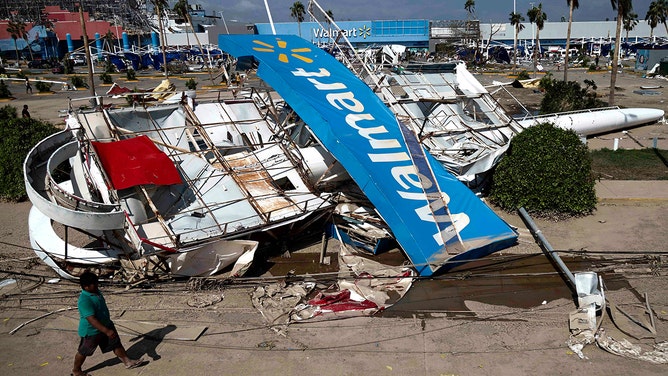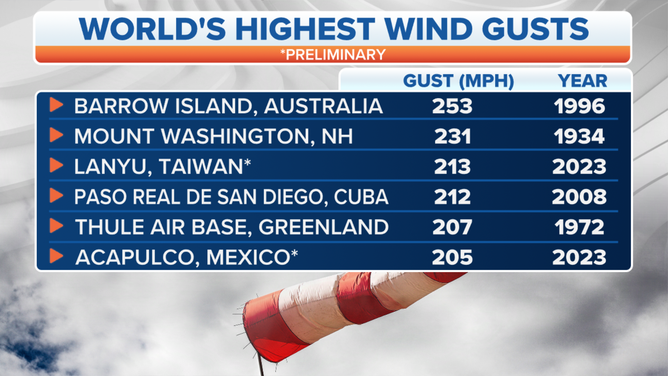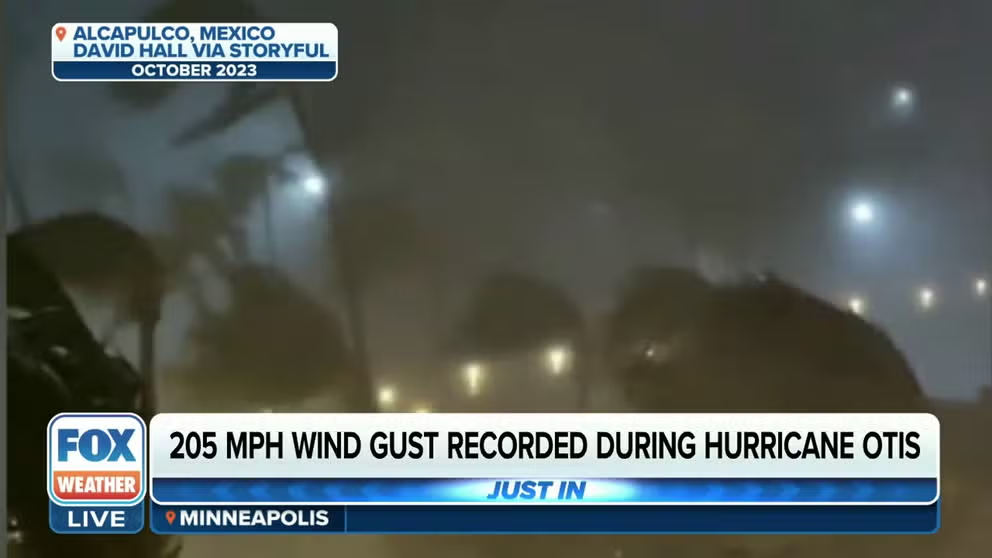205-mph wind gust from Mexico’s Hurricane Otis likely ranks among world's highest
Hurricane Otis struck the southern Pacific coast of Mexico near Acapulco on Oct. 25. It was classified as a Category 5 hurricane with sustained winds of 165 mph, making it the strongest hurricane on record to make landfall on the Pacific side of Mexico, according to the National Hurricane Center.
205 mph wind gust recorded during Hurricane Otis
The National Autonomous University of Mexico's Tidal Service confirms a weather station recorded a 205 mph wind gust during Hurricane Otis, which would mark one of the strongest wind speeds ever recorded on earth.
ACAPULCO, Mexico – One of the world's highest wind gusts on land was clocked at 205 mph as Hurricane Otis battered Mexico last month, researchers discovered.
Otis struck the country's southern Pacific coast near Acapulco on Oct. 25 at 1:25 a.m. CDT. It was classified as a Category 5 hurricane with sustained winds of 165 mph, making it the strongest hurricane on record to make landfall on the Pacific side of Mexico, according to the National Hurricane Center (NHC).
SEE HURRICANE OTIS' WIDESPREAD DAMAGE TO ACAPULCO, MEXICO THROUGH SATELLITE IMAGES

Residents walk past debris in the aftermath of hurricane Otis in Acapulco, Guerrero State, Mexico, on October 27, 2023.
(RODRIGO OROPEZA / AFP / Getty Images)
Following the storm, the National Tidal Service of the National Autonomous University of Mexico said it sent two technicians to Acapulco to recover hurricane data from its two monitoring stations in the city.
"Considering the trajectory and size of Otis, it was of utmost importance to recover the information, which was practically the record of the center of the hurricane," the agency said.
The record-breaking burst of wind was recorded at 12:40 a.m., according to the agency, which puts Otis very close to the Eastern Pacific record set by Hurricane Patricia off the coast of Mexico in October 2015. Patrica's peak intensity over the ocean was estimated at 185 knots (213 mph), according to the NHC.
The world's highest wind gust on land of 253 mph was recorded in April 1996 at Barrow Island, Australia, during Tropical Cyclone Oliva.

The highest wind gusts recorded in the world as of Nov. 3, 2023.
(FOX Weather)
FOX Weather hurricane specialist said both the wind speed at landfall and the gust measurement will be evaluated.
"Otis clearly weakened in the hours before landfall, so I wouldn't be surprised if it was a notch weaker," Norcross said. "And the instrument that measured the gust will be evaluated. Quite often, anemometers are not well calibrated at those high wind speeds, and also the location will be checked to see if that influenced the measurements."
Acapulco survivor surveys Hurricane Otis' devastation
As the ferocious Category 5 Hurricane Otis storm made landfall in the southern state of Guerrero, Jaime Villanueva and his friend, Barbara, found themselves seeking refuge on the 21st floor of the Solar Ocean Hotel.
The devastating winds from Otis resulted in extensive destruction, causing damage to 80% of Acapulco's hotels, according to government officials. The storm was followed by power and internet outages, as well as citywide looting. Severe damage also shuttered commercial and military airports of Acapulco.
‘ACAPULCO HAS BEEN DESTROYED’: HURRICANE OTIS SURVIVORS RECOVER FROM HISTORIC STORM
As of last check, the death toll has risen to at least 46 people, with nearly 60 people still missing, the Mexican government said.
Days following landfall, rescue crews were unable to reach the city to provide aid due to mudslides in mountainous terrain. The deployed 10,000 troops lacked the necessary tools to clear the roads obstructed by mud and fallen trees, the Associated Press reported.
According to the NHC, Otis’ peak intensification rate was 110 mph in 24 hours, the second-highest recorded rate in the Western Hemisphere, behind only Patricia in October 2015.
In the photo below, the National Tidal Service provided a before-and-after comparison of its weather station located in Acapulco Bay. The weather station was the only structure that remained standing after the storm, as the entire perimeter fence had been destroyed.
HOW DID HURRICANE OTIS' RECORD INTENSIFICATION CATCH ADVANCED FORECAST MODELS BY SURPRISE?
The Mexican Red Cross has delivered 75 tons of humanitarian aid to those affected by the disaster, while more than 1,600 people are still staying in shelters in both Acapulco and Coyuca de Benítez.
Editor's note: An earlier version of this story listed the Otis wind gust as the fifth-highest in the world. That reference has been removed after a reevaluation of record data by FOX Weather.





